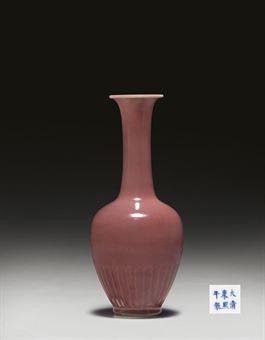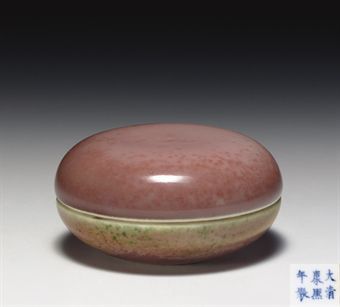A collection of peachbloom-glazed porcelains @ Christie's Fine Chinese Ceramics & Works of Art
A peachbloom-glazed chrysanthemum vase, juban ping. Kangxi six-character mark in underglaze blue and of the period (1662-1722)
The elegant ovoid body molded with a band of chrysanthemum petals above the rounded foot and surmounted by a tall neck flaring towards the white rim, the exterior covered with a greyish-rose glaze with areas of deep rose mottling and shading to paler tone in the recesses of the chrysanthemum band to outline the petals, the interior of the mouth of matching rose tone finely mottled with tiny flecks of paler tone and dark green. 8½ in. (21.5 cm.) high - Est. $50,000 - $80,000
Notes: Vases of this type are also known as heban ping, referring to the narrow petals as being lotus rather than chrysanthemum petals. This was the opinion of Ralph M. Chait in his article, 'The Eight Prescribed Peachbloom Shapes bearing K'ang Hsi Marks', Oriental Art, vol. III, No. 4, Winter 1957, pp. 130-7. However, over time they have become most commonly known as 'chrysanthemum' vases, or juban ping. They are one of the peachbloom-glazed vessels known as the 'Eight Great Numbers', ba da ma, which are some of the most sophisticated and distinguished of all imperial porcelains.
Stephen Bushell in Oriental Ceramic Art: illustrated Examples from the Collection of W.T. Walters, 1899, New York, new ed., London, 1981, discussses the variations in the peachbloom glaze and notes that "the Chinese, in comparing the colour, have thought of the apple rather than the peach; it is pingguo hong (apple red), and the markings on it are pingguo qing (apple green), and mei gui ci (rose-crimson)," as well as "jiangdou hong (bean red), in allusion to the small Chinese kidney bean, with its variegated pink colour and brown spots."
Vases of this type are in major institutions and collections worldwide. See, also, the example sold in these rooms, 29 March 2006, lot 450.
A peachbloom-glazed chrysanthemum vase, juban ping. Kangxi six-character mark in underglaze blue and of the period (1662-1722)
The ovoid body with a band of chrysanthemum petals molded above the rounded foot and surmounted by a tall neck flaring towards the rim, covered with a glaze of deep rose color thinning to pale pink on the rim above a line of deep rose and then mottled apple-green color on the inside of the mouth and neck. 8 5/8 in. (21.7 cm.) - Est. $30,000 - $50,000
A peachbloom-glazed water pot, taibai zun. Kangxi six-character mark in underglaze blue and of the period (1662-1722)
The domed body incised with three dragon roundels and covered with a glaze of soft pink tone finely mottled in soft crushed strawberry red in contrast to the white rim. 5 in. (12.7 cm.) diam. - Est. $20,000 - $40,000
A peachbloom-glazed beehive waterpot, taibai zun. Kangxi six-character mark in underglaze blue and of the period (1662-1722)
The domed body incised with three dragon roundels and covered with a glaze of soft crushed strawberry-red color thinning to a paler greyish-green tone on the sloping shoulders and continuing down the sides stopping short of a deep rose band at the base. 5 in. (12.7 cm.) diam. Est. $18,000 - $25,000
A peachbloom-glazed water pot, taibai zun. Kangxi six-character mark in underglaze blue and of the period (1662-1722)
The domed body incised with three dragon roundels and covered with a glaze of rich crushed strawberry red tone thinning in areas to mushroom and to pale greenish-mushroom on the waisted neck between a line of brownish color at the base of the neck and a line of crushed strawberry tone at the edge of the white rim. 5 in. (12.7 cm.) diam. Est. $10,000 - $15,000
Notes: Waterpots of this form are known as taibai zun, after the Tang dynasty poet Li Bai, who is often depicted leaning against a large wine jar of similar form. They are also known as qizhao zun because their shape resembles that of a chicken coop. Such waterpots belong to the group of eight peachbloom wares, the 'Eight Great Numbers', ba da ma, of which a complete set is in the Metropolitan Museum of Art, illustrated by S. Valenstein, A Handbook of Chinese Ceramics, New York, 1989 (rev. ed.), p. 237. Another complete set of eight from the Jingguantang Collection was sold in our Hong Kong rooms, 3 November 1996, lot 557.
Similar waterpots can be found in many important collections including the Palace Museum, Beijing and the Percival David Foundation, London. See, also, the example sold in these rooms, 19 September 2007, lot 342.
A peachbloom-glazed amphora, liuye zun. Kangxi six-character mark in underglaze blue and of the period (1662-1722)
The high-shouldered, tapering body covered with a mottled glaze of rich rose color with some darker mottling, the glaze ending in a line above the unglazed foot, the interior of the mouth and neck with a glaze of slightly darker tone suffused with a faint, pale apple-green cloud. 6 1/8 in. (15.5 cm.) high, bronze stand - Est. $10,000 - $15,000
A peachbloom-glazed brush washer, tangluo xi. Kangxi six-character mark in underglaze blue and of the period (1662-1722)
Of compressed globular form, the exterior covered with a glaze of soft crushed strawberry tone thinning in areas to mushroom, with white interior and a blush of pink to the inner edge of the white rim. 4 5/8 in. (11.7 cm.) diam. Est. $8,000 - $12,000
Notes: This type of brush washer is described as of 'gong' shape, or tangluo xi, as it has a very compressed body.
It belongs to a group of eight vessel shapes referred to as the ba da ma, 'Eight Great Numbers', all covered in a peachbloom glaze and thought to have been devised to serve as requisite appointments for the Emperor's writing table. However, according to J. Ayers, 'The Peachbloom Wares of the Kangxi Period', TOCS, vol. 64, 1999-2000, pp. 31-50, they may have been made as presents to be presented at court. To see a similar washer within the context of a complete set, see S. Valenstein, The Handbook of Chinese Ceramics, New York, 1989 (rev. ed.), p. 237. See, also, the brush washer sold in these rooms, 19 March 2008, lot 636.
A peachbloom-glazed amphora, liuye zun. Kangxi six-character mark in underglaze blue and of the period (1662-1722)
The high-shouldered, tapering body covered with a greyish-pink glaze with some bright pink mottling on the shoulder and ending in a neat line where the biscuit body is exposed above the countersunk foot, the interior of the mouth of reddish-rose color with some apple-green mottling. 6 1/8 in. (10.5 cm.) high, bronze stand - Est. $8,000 - $12,000
Notes: The shape of this vessel, Guanyin ping, refers to the shape of the vase held by many figures of Guanyin, and said to contain ambrosia or magic elixir. It is also known as liuye ping, 'willow-leaf vase', owing to its elegant form which resembles that of a willow leaf. It is one of the ba da ma or 'Eight Great Numbers', eight specific vessels covered in a peachbloom glaze.
Similar examples are in major institutions worldwide including the Palace Museum, Beijing; the Shanghai Museum; The Metropolitan Museum of Art; the National Palace Museum, Taipei; the Baur Collection, Geneva and the Meiyintang Collection. See, also, the example sold in our Hong Kong rooms, 30 May 2005, lot 1233.
A peachbloom-glazed seal paste box, yinse he. Kangxi six-character mark in underglaze blue and of the period (1622-1722)
Of cushion form, the cover and box covered in a mottled glaze of soft reddish and greyish-pink color. 2 7/8 in. (7.3 cm.) diam. - Est. $6,000 - $8,000
Notes: This type of seal paste box forms one on the ba da ma or 'Eight Great Numbers', a group of eight specific vessels covered in a peachbloom glaze.
A similar example from the Jingguantang Collection was sold as part of a complete set in our Hong Kong rooms, 3 November 1996, lot 557. Others are in museum collections including the Palace Museum, Beijing, illustrated in Kangxi Yongzheng Qianlong, Hong Kong, 1989, p. 141, col. pl. 124; The Metropolitan Museum of Art, illustrated by S. Valenstein, A Handbook of Chinese Ceramics, New York, 1975, pl. 138; and the National Palace Museum, Taipei, included in the Special Exhibition of Kangxi, Yongzheng, Qianlong Porcelain, 1988, no. 11.
A peachbloom-glazed seal-paste box and cover, yinse he. Kangxi six-character mark in underglaze blue and of the period (1662-1722)
The box and cover of cushion form, covered with a mottled glaze of soft crushed strawberry tone suffused with pale greenish clouds around the sides. 2¾in. (7 cm.) diam - Est. $6,000 - $8,000
A peachbloom-glazed seal-paste box and a cover, yinse he. Kangxi six-character mark in underglaze blue and of the period (1662-1722)
The circular box and cover of cushion form, covered with a glaze of faintly mottled greyish crushed-strawberry color thinning to a paler tone flecked with green on the sides of the box and stopping neatly above the ring foot. 2¾ in. (7 cm.) diam. - Est. $3,000 - $5,000
Christie's. Fine Chinese Ceramics & Works of Art Including Property from the Arthur M. Sackler Collections. 15 September 2009. New York, Rockefeller Plaza. Image 2009 Christie's Ltd www.christies.com

/https%3A%2F%2Fprofilepics.canalblog.com%2Fprofilepics%2F1%2F0%2F100183.jpg)
/https%3A%2F%2Fstorage.canalblog.com%2F03%2F02%2F119589%2F96711876_o.jpg)
/https%3A%2F%2Fstorage.canalblog.com%2F11%2F31%2F119589%2F94773502_o.jpg)
/https%3A%2F%2Fstorage.canalblog.com%2F20%2F83%2F119589%2F94772815_o.jpg)
/https%3A%2F%2Fstorage.canalblog.com%2F26%2F72%2F119589%2F75604929_o.jpg)
/https%3A%2F%2Fstorage.canalblog.com%2F59%2F60%2F119589%2F26458628_o.jpg)













/http%3A%2F%2Fstorage.canalblog.com%2F79%2F84%2F119589%2F121121505_o.png)
/http%3A%2F%2Fstorage.canalblog.com%2F80%2F42%2F119589%2F120611565_o.jpg)
/http%3A%2F%2Fstorage.canalblog.com%2F79%2F49%2F119589%2F113206128_o.jpg)
/http%3A%2F%2Fstorage.canalblog.com%2F80%2F78%2F119589%2F113206111_o.jpg)